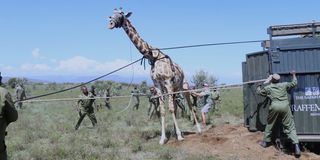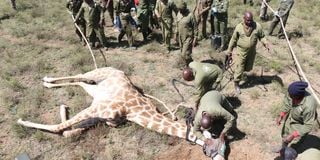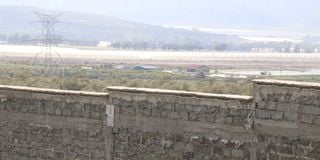Kedong to remain on WRC Safari Rally route despite ranch subdivision

Kenya Wildlife Service rangers restrain a Maasai giraffe at the Kedong Ranch during a large-scale relocation of wildlife due to uncontrolled land use following a change in ownership.
If you’ve driven along Moi South Lake Road recently, you’ve probably noticed the flurry of activity around Kedong Ranch: new boundaries and markers, and an unmistakable sense of change. If you’re a rally enthusiast, you’ve probably wondered whether the iconic Kedong stage will survive the changes ahead of the 2026 WRC Safari Rally.
Take a breath. The answer is yes. Kedong is here to stay.
The 2026 World Rally Championship Safari Rally will return, delivering all the adrenaline, dust and show-stopping drama that fans have come to expect. However, this time it will unfold against an evolving landscape, as changes in land use and ownership take shape across the area.
For years, Kedong has been so much more than just another stage on the rally map. It's a slice of wilderness where machines meet nature, a place where rally cars, antelopes, zebras and giraffes often share the same open horizon. Fans flock there to witness the legendary Miti Mbili jump, that heart-stopping moment when a car launches into the air amid a cloud of dust and raw power. For many, Kedong represents the old soul of the Safari Rally: unpredictable, rugged and unforgettable.

Kedong Ranch in Naivasha.
So, when news of land partitioning and ownership changes began to circulate, there was speculation that this cherished section might be dropped from the 2026 route.
However, George Mwangi, Clerk of the Course for the WRC Safari Rally, says this is not the case.
"We are still using Kedong. We are in discussions with the landowners, who have been very supportive. The routes will not be affected entirely. We are on good terms and working closely together,” he reassures.
According to Mr Mwangi, planning for the 2026 edition began in July, taking into account the changing land dynamics. The core layout of the stage remains intact, and the famous tree jump — a magnet for photographers and fans alike — is staying put.
“The Miti Mbili area is one of the highlights of the Kedong stage. It’s still in our plans, and we are committed to maintaining that level of excitement,” he says.

Kenya Wildlife Service rangers restrain a Maasai giraffe at the Kedong Ranch during a large-scale relocation of wildlife due to uncontrolled land use following a change in ownership.
For spectators wondering whether they’ll still get premium views of the action, Mwangi has even better news:
"This event is spectator-driven; they are our main clients. A rally without spectators is like football in an empty stadium,” he explains. As the final route is being finalised, the team is also mapping out spectator stages, which will be announced next year.
Fans can expect an official guide early next year, once the plans have been approved by the FIA and rally promoters. This will detail access points, viewing zones and additional activities designed to enhance the rally experience.

New greenhouses have been erected at Kedong Ranch in Naivasha, a popular spot for the World Rally Championship's spectator stage and rally routes.
"We have 61 deadlines to meet before the event. So far, we have cleared 11. But all is well we are on track to deliver a spectacular event," he says.
Kedong’s roots in rally history run deep. It has hosted countless WRC and KNRC events, long before the Safari Rally's celebrated return under former President Uhuru Kenyatta's administration.
"Kedong is an old stage classic. We have rallied there for many years. It’s part of our story,” Mr Mwangi says.

The Maasai giraffes can be found at the Kedong Ranch in Naivasha, a popular spot for spectators during the World Rally Championship.
So, while boundaries may be shifting and the land transforming, when the 2026 WRC Safari Rally begins, Kedong will once again reverberate with the sound of engines and cheering crowds. The only real difference next year? The wildlife will sit this one out.


